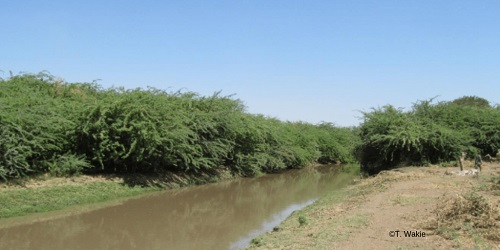
BY EPHREM ANDARGACHEW
Currently, biodiversity loss and ecological catastrophe have become hot topics in the world. It also affects every individual and country of the world. As a result, the loss of biological diversity matter to humans and the world is facing huge challenges.
Biodiversity is a contraction of biological diversity. It indicates the number, variety, and variability of living organisms and how these change from one location to another and over time. Biodiversity consists of variety within species (species diversity), among species (species diversity), and between ecosystems (ecosystems diversity).
Conservation of biodiversity is essential in all ecosystems, not only in those that are “natural” like national parks or nature preserves, but also in those that are supervised by humans namely farms and plantations, and even urban parks. Biodiversity provides multiple benefits to both the ecosystems and humans. Because biodiversity supports all life on Earth, and refers to biological variety in all its forms, from the genetic makeup of plants and animals to cultural diversity.
According to Kotebe Education University Biology Department Assistant Professor Bruktawit Abdu, the protection and conservation of biodiversity has various ecosystem benefits to Ethiopia. First, it provides services such as food, clean water, timber, fibre, and genetic resources. Second, it regulates services like the regulation of climate, floods, disease, water quality, and pollination. Third, it has cultural services such as recreational, aesthetic, and spiritual benefits; and fourth, it supports services such as soil formation, and nutrient cycling.
“Therefore, the local loss of essential biodiversity species can interrupt ecosystem services for a long time. Changes in the interactions between species can also lead to negative impacts on ecosystem processes”, she said.
It is true that Ethiopia, as part of this globe, is rich in biodiversity. The main phytogeographic landscapes are massive highland mountains and plateau divided by the Great Rift Valley and bounded by lowlands along the periphery. There is a great altitudinal variation from 116 meters below sea level to 4620 meters above sea level. Though Ethiopia is a tropical country with typically hot and dry lowland areas, it has diverse macro and micro-climatic conditions.
Studies have shown that Ethiopia is one of the twelve known ancient nations for crop plant diversities in the world and has valuable reserves of crop genetic diversity, of which 11 cultivated crops have their centre of diversity in the country. The extensive and unique conditions in the highlands of the country have contributed to the presence of numerous endemic species.
Ethiopian Biodiversity Institution Director Dr Melese Mario told The Ethiopian Herald that Ethiopia is endowed with plentiful natural resources such as adequate landmass, fertile soil, favourable climate, water, wildlife, and so on. Ethiopian biodiversity resources have been classified into three main groups namely animals, plants, and microbial. These biodiversity resources have both direct and indirect benefits to the country.
The direct benefits of biodiversity include food consumption. Because more than 70 per cent of plants are used for food consumption. It has been also used for fodder, fuel, fibre, medicine since more than 70 per cent of the people in developing countries use plants as a primary source of medicine, natural compounds, gene pool source, and so on, while the indirect benefits comprise climate regulation, soil management, waste disposal, nutrient cycling, hydrological regime, species interactions, eco-tourism, recreation, and research. Nevertheless, the nation’s biodiversity is not free from challenges, he said.
Extreme or persistent poverty, climate change, over-exploitation of natural resources by the growing population of the country, over-use of marginal lands, deteriorating soil health (degradation, erosion, and landslides). Salination of fertile lands and waterlogging, floods, and drought are among the key developmental challenges of the country’s biodiversity conservation.
Furthermore, invasive alien species are the most dangerous plants for the loss of biodiversity in Ethiopia. Currently, more than 1.8 million hector land has been covered by immigrant weeds in Ethiopia. Nearly, 35 invasive alien plant species are bringing negative impacts on native biodiversity, agricultural lands, rangelands, national parks, waterways, lakes, rivers, power dams, roadsides, urban green spaces with great economic and social impacts. This has brought major challenges for the conservation biodiversity of the area.
Thus, losing biodiversity means a lot to Ethiopia. When any species is lost, the world will also lose both the physicals and conceptual knowledge of the biodiversity items. Humans also lose food and clothes items, cultural practices which are related to the food items, materials for the construction of houses, and so on. Besides, as a human lose oxygen which is the most important thing in life, he explains.
Wassie, S.B. (2020) in his academic article “Natural resource degradation tendencies in Ethiopia: a review” stated that in Ethiopia, biodiversity resources are under the influence of various interrelated factors. These results in severe soil loss, low vegetative cover, unsustainable farming practice, nonstop use of dung and crop residues for fuel, overgrazing, and destruction and migration of wildlife, which again are intensifying the degradation of available resources in a vicious circle. These have been creating environmental consequences such as water quality deterioration, biodiversity decline, and averts ecosystem services. It further recapitulates diverse socio-economic problems, political instability, marginalization, poverty, and recurrent natural hazards.
Addressing biodiversity challenges would indeed solve problems related to climate change and disaster risk, food and water security, socio-economic development, and human health.
The Ethiopian government has taken several measures to address these problems like launching soil and water conservation campaign, tree planting programs, and others; success to date, however, has been limited.
According to Dr Melese, nature-based solutions, apart from government policies, international treaties, agreements, are key to protect, sustainably manage, and restore natural or modified ecosystems, that address societal challenges effectively and adaptively, simultaneously providing human well-being and biodiversity benefits.”
More importantly, creating awareness, broadening the livelihoods of the people, avoiding and carefully controlling existing or imported invasive alien species, applying integrated cross-sectoral check and balance tasks, and developing socio-cultural ethical programs are important to ensure the conservation of biodiversity.
However, Ethiopia is one of the least urbanized countries in Africa, but urbanization is growing steadily. The government or any concerned body should critically identify urbanization places. Because some places which are selected for urbanization are highly fertile and appropriate for agricultural activities.
Mechanized agriculture is also another solution to the conservation of biodiversity in Ethiopia. Because Ethiopia uses around 45 per cent of arable land which is found in the highlands of the country while the remaining 55 per cent of the low land of Ethiopia has untapped agricultural potential. If it is used properly, it will provide enough product and production. Therefore, the government must start mechanized agriculture in the low lands of Ethiopia to minimize the burden of highlanders plants. Because conserving the biodiversity of the country is a matter of survival, not a luxury.
The Ethiopian Herald December 5/2021




